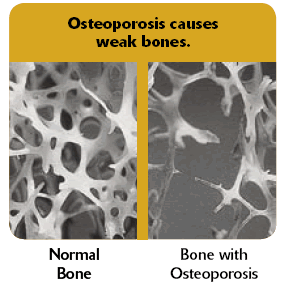Do
HIV Positive People Have a Higher Risk of Bone Fractures?
 |
 |
 |
 |
 |
 |
 |
| SUMMARY:
Older people with HIV may be more likely to sustain
bone fractures than HIV negative individuals of the
same age, according to research presented last week
at the 1st International Workshop on HIV and Aging in
Baltimore. However, another recent study, published
in the September
20, 2010, advance online issue of AIDS, did
not see more bone breaks among HIV positive compared
with at-risk HIV negative participants in the Women's
Interagency HIV Study. |
|
 |
 |
 |
 |
 |
 |
 |
By
Liz Highleyman
 A
growing body of research indicates that people with HIV are at
higher
risk for bone problems compared with the general population,
including reduced bone density (osteopenia) and more advanced
bone loss known as osteoporosis. It has not yet been established
whether this is due to HIV infection itself, inflammation, antiretroviral
therapy, or some combination of these and other factors. A
growing body of research indicates that people with HIV are at
higher
risk for bone problems compared with the general population,
including reduced bone density (osteopenia) and more advanced
bone loss known as osteoporosis. It has not yet been established
whether this is due to HIV infection itself, inflammation, antiretroviral
therapy, or some combination of these and other factors.
As
described at a new conference dedicated to concerns of HIV positive
people as they age, L. Mundy and colleagues from GlaxoSmithKline
(GSK) performed a retrospective cohort study to assess the incidence
of fractures among adults with and without HIV infection.
Reduced
bone mineral density (BMD) is a known risk factor for fractures.
But while research supports an association between HIV and bone
loss, there is little data about the link between HIV and fractures,
the investigators noted as background.
This
analysis included more than 200,000 participants age 18 and older
enrolled in the Ingenix Impact National Benchmark Database for
more than 12 months between January 1997 and March 2008. The researchers
looked at incident (new) low-impact, non-traumatic fractures,
that is, bone breaks not caused by trauma such as accidents.
The
final cohort included 238,336 participants, of whom 59,584 (25%)
were HIV positive. Each HIV positive patient was matched with
3 HIV negative individuals according to sex, date of enrollment,
and duration of follow-up. A majority of participants (72%) were
men. Notably, only about half were on antiretroviral therapy (ART).
Known
fracture risk factors were uncommon overall. People in the HIV
positive group were significantly more likely than those in the
HIV negative group to report heavy alcohol consumption (3% vs
1%, respectively), excessive steroid use (6% vs 4%), low body
weight (8% vs 2%), lipodystrophy (3% vs < 1%), and coinfection
with hepatitis B (4% vs < 1%) or hepatitis C (7% vs < 1%).
People in the HIV negative group were more likely to use bisphosphonate
drugs to manage osteoporosis (2% vs 1%), and the groups were about
equally likely to have had previous fractures (about 2%).
Results
 |
Overall,
9027 participants (3.8%) sustained fractures over 13,757 person-years
of follow-up: |
| |
 |
4.2%
of HIV positive participants: hazard ratio (HR) 2.02; |
 |
3.7%
of HIV negative participants: HR 1.77. |
|
 |
The
fracture incidence rate ratio was 1.14, or 14% higher for
HIV positive vs HIV negative patients. |
 |
In
a multivariate analysis, the following factors were significant
fracture risk factors overall: |
| |
 |
Prior
fractures: HR 4.49, or more than 4 times higher risk; |
 |
Low
physical activity: HR 2.59, or more than 2 times higher
risk; |
 |
Heavy
alcohol use: HR 1.90, or nearly double the risk; |
 |
Bisphosphonate
use: HR 1.49, or about 50% higher risk; |
 |
Low
body weight: HR 1.32, or about 30% higher risk. |
|
 |
Risk
factors varied significantly by age group when models were
stratified by age categories (<30, 30-59, or > 59 years). |
 |
Among
patients < 30 years, the only significant predictors were: |
| |
 |
Prior
fractures: HR 7.77; |
 |
Heavy
alcohol use: HR 2.24. |
|
 |
In
the 30-59 year group, the risk factors that were significant
in the full model remained significant, along with some additional
factors: |
 |
Prior
fractures: HR 3.81; |
 |
Low
physical activity: HR 2.24; |
 |
Heavy
alcohol consumption: HR 1.86; |
 |
Bisphosphonate use: HR 1.36; |
 |
Low
body weight: HR 1.30; |
 |
HIV
infection without AIDS: HR 1.18; |
 |
HIV
infection with AIDS: HR 1.15; |
 |
Vitamin
D deficiency or use of vitamin D or calcium supplements:
HR 0.72, or a slightly lower risk. |
|
 |
Among
participants > 59 years, the only significant risk factors
were: |
 |
 |
Prior
fractures: HR 2.79; |
 |
Low
physical activity: HR 2.65. |
|
 |
Fracture
risk increased significantly more with advancing age among
HIV positive people with and without AIDS (CD4 count <
200 cells/mm3 or opportunistic infections) compared with HIV
negative participants. |
"Incidence
of fracture was significantly higher among subjects with HIV infection
compared to subjects without HIV infection," the investigators
concluded. "Prior fracture was the strongest risk predictor
in all age strata, with additional age-stratified differentiation
of modifiable risks that have implications for clinical practice
and preventive medicine."
Notably,
this study did not report associations between fractures and ART
use or specific antiretroviral drugs or drug classes.
WIHS
Women
As described in the second report, Michael Yin, Phyllis Tien,
and fellow investigators with the Women's Interagency HIV Study
(WIHS) measured time to self-reported first new fractures at any
body site among 2391 women in the cohort, of whom 1728 were HIV
positive and 663 were HIV negative.
The clinical importance of the association between HIV infection
and ART use with low BMD in pre-menopausal women is uncertain
because bone density tends to stabilize on established ART and
fracture data are limited, the researchers noted as background.
At baseline, the HIV positive women were significantly older (40
vs 36 years), more likely to be post-menopausal, and more like
to have hepatitis C coinfection compared with the HIV negative
group. A majority were back or Latina in both groups. Overall,
about half were current cigarette smokers. Among the HIV positive
women, the average CD4 cell count was 482 cells/mm3 and 66% were
on ART. The median follow-up duration was 5.4 years.
Results
 |
148
HIV positive women (8.6%) and 47 HIV negative women (7.1%)
sustained new fractures during follow-up. |
 |
Fracture
incidence rates were 1.8 per 100 person-years among HIV positive
women vs 1.4 per 100 person-years among HIV negative women. |
 |
The
likelihood of new fractures did not differ significantly between
the HIV positive and HIV negative groups in an unadjusted
analysis or after adjusting for known risk factors. |
 |
In
a multivariate model, significant predictors of new fractures
were: |
| |
 |
Older
age; |
 |
White
vs black race; |
 |
Hepatitis
C coinfection; |
 |
Higher
serum creatinine (a potential indicator of kidney impairment). |
|
 |
Among
HIV positive women, significant fracture predictors were: |
| |
 |
Older
age; |
 |
White
vs black race; |
 |
Hepatitis
C coinfection; |
 |
History
of AIDS-defining illnesses; |
 |
Current
or past cigarette smoking; |
 |
History
of opiate use. |
|
 |
HIV
serostatus and CD4 cell count, however, were not statistically
significant fracture risk factors. |
 |
There
was also no observed link between fractures and use of any
antiretroviral drug class or particular drug, including tenofovir
(Viread, also in the Truvada
and Atripla
coformulations). |
Based
on these findings, the study authors concluded, "Among predominantly
pre-menopausal women, there was little difference in fracture
incidence rates by HIV status, rather traditional risk factors
were important predictors."
Although fracture risk was "modest" overall in this
mostly pre-menopausal group, they recommended that, "Further
research is necessary to characterize fracture risk in HIV-infected
women during and after the menopausal transition."
Investigator affiliations: Mundy study: GlaxoSmithKline, WW
Epidemiology, Collegeville, PA; GlaxoSmithKline, WW Epidemiology,
Research Triangle Park, NC; GlaxoSmithKline, WW Epidemiology,
Boston, MA; GlaxoSmithKline and Medco Health Services Inc., WW
Epidemiology and Research, Collegeville and Blue Bell, PA.
Yin study: Columbia University Medical Center, New York, NY; New
York Medical College, Valhalla, New York, NY; Rutgers University,
Piscataway, NJ; Montefiore Medical Center, Bronx, New York, NY;
State University of New York, Downstate, Brooklyn, NY; Georgetown
School of Medicine, Washington DC; Keck School of Medicine, University
of Southern California, Los Angeles, CA; Departments of Medicine,
Stroger Hospital and Rush University, Chicago, IL; Department
of Epidemiology, Johns Hopkins Bloomberg School of Public Health,
Baltimore, MD; San Francisco Veterans Affairs Medical Center,
University of California at San Francisco, CA.
10/15/10
References
LM
Mundy, H Li, S St. Laurent and S Bowlin. Age-stratified risk assessment
for fracture among adults with and without HIV infection. 1st
HIV and Aging workshop. Baltimore, October 4-5, 2010. Abstract
O_07.
MT
Yin, Q Shi, DR Hoover, PC Tien, and colleagues. Fracture incidence
in HIV-infected women: results from the Women's Interagency HIV
Study. AIDS (Abstract).
September 20, 2010 (Epub ahead of print).
|
|
|
|
 |
|
Stories
of Success in HIV: Proven Interventions for Improving
wareness, Testing, Access to Care, and Treatment of HIV in
Communities of Color.
|
|
|
|
 |
|
Stories
of Success in HIV: Proven
Interventions for Improving wareness, Testing, Access to Care,
and Treatment of HIV in Communities of Color.
|
|
|
